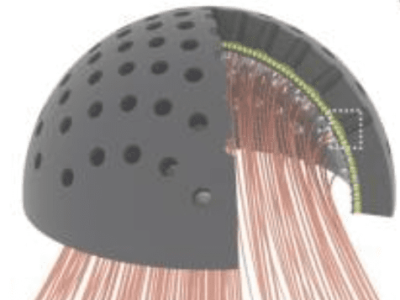
Stretchable pump powers lightweight soft robots

Flexible, silent and weighing only one gram, the tiny pump could replace the rigid, noisy and bulky pumps currently used in soft robotics. Publishing their results in Nature under the title “Stretchable pumps for soft machines”, the scientists created the soft flexible pumps to eliminate the rigid pumps tethering so far soft robots.
Soft robots have a distinct advantage over their rigid forebears: they can adapt to complex environments, handle fragile objects and interact safely with humans. Made from silicone, rubber or other stretchable polymers, they are ideal for use in rehabilitation exoskeletons and robotic clothing. Soft bio-inspired robots could one day be deployed to explore remote or dangerous environments.
In the new pump design, even the electrodes are flexible. The pump is completely silent and consumes very little power, which it gets from a 20x20mm circuit that includes a rechargeable battery.

“If we want to actuate larger robots, we connect several pumps together,” explains Herbert Shea, director of EPFL’s Soft Transducers Laboratory (LMTS). Soft pumps can also be used to circulate liquids in thin flexible tubes embedded in smart clothing, leading to garments that can actively cool or heat different regions of the body. That would meet the needs of surgeons, athletes and pilots, for example.
The soft and stretchable pump is based on the physical mechanism used today to circulate the cooling liquid in systems like supercomputers. The pump has a tube-shaped channel, 1mm in diameter, inside of which rows of electrodes are printed. The pump is filled with a dielectric liquid. When a voltage is applied, electrons jump from the electrodes to the liquid, giving some of the molecules an electrical charge. These molecules are subsequently attracted to other electrodes, pulling along the rest of the fluid through the tube with them.
“We can speed up the flow by adjusting the electric field, yet it remains completely silent,” says Vito Cacucciolo, a post-doc at the LMTS and lead author of the study.

The researchers have successfully implanted their pump in a type of robotic finger widely used in soft robotics labs. They are now collaborating with Koichi Suzumori’s laboratory in Japan, which is developing fluid-driven artificial muscles and flexible exoskeletons.
The EPFL team has also fitted a fabric glove with tubes and shown that it is possible to heat or cool regions of the glove as desired using the pump. “It works a little like your home heating and cooling system” says Cacucciolo. This application has already sparked interest from a number of companies.
EPFL – www.epfl.ch
Related articles:
Soft robotics proprioception: Let the machine sort it out
Carbon-laden foam makes super-sensitive pressure sensor
A Futuristic Look at the Development Towards Soft Robotics
Soft 3D-printed magnetic robots can crawl and jump, untethered
Light nerves to equip soft robots
 If you enjoyed this article, you will like the following ones: don't miss them by subscribing to :
eeNews on Google News
If you enjoyed this article, you will like the following ones: don't miss them by subscribing to :
eeNews on Google News



